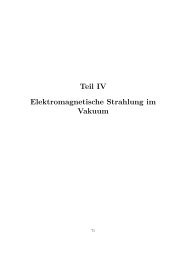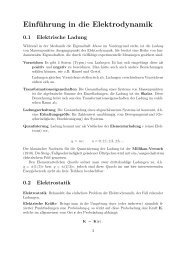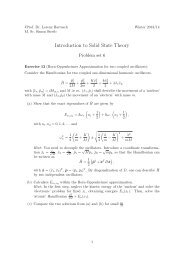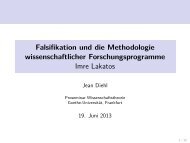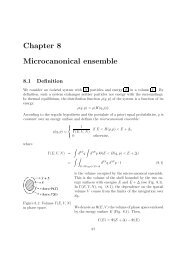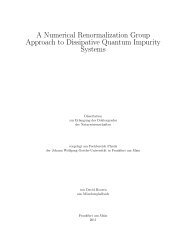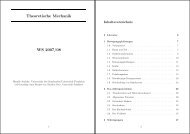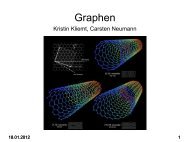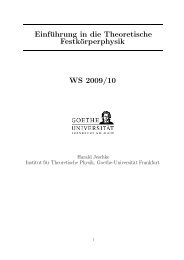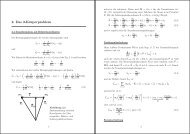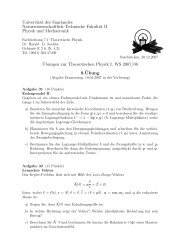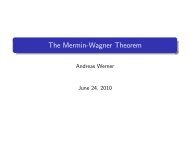Microscopic Modelling of Correlated Low-dimensional Systems
Microscopic Modelling of Correlated Low-dimensional Systems
Microscopic Modelling of Correlated Low-dimensional Systems
You also want an ePaper? Increase the reach of your titles
YUMPU automatically turns print PDFs into web optimized ePapers that Google loves.
List <strong>of</strong> Figures<br />
2.1 Schematic representation <strong>of</strong> the division <strong>of</strong> the unit cell done in APW/LAPW<br />
method. . . . . . . . . . . . . . . . . . . . . . . . . . . . . . . . . . . . . . . 17<br />
2.2 Atomic Sphere Approximation (ASA) in which the muffin tin spheres are<br />
chosen to have the same volume as the Wigner-Seitz cell, which leads to<br />
overlapping spheres [77]. . . . . . . . . . . . . . . . . . . . . . . . . . . . . . 21<br />
3.1 Representation <strong>of</strong> a Triclinic unit cell. . . . . . . . . . . . . . . . . . . . . . 35<br />
3.2 The Brillouin zone for a triclinic lattice. In it are shown high symmetry<br />
points: Γ = (0, 0, 0), F=(0, 1/2, 0), B=(1/2, 0, 0) and G=(0, 0, 1/2), in units<br />
<strong>of</strong> (π/a, π/b, π/c) . . . . . . . . . . . . . . . . . . . . . . . . . . . . . . . . . 36<br />
3.3 Representation <strong>of</strong> a primitive monoclinic unit cell. . . . . . . . . . . . . . . 37<br />
3.4 The first Brillouin zone for a monoclinic lattice. The high symmetry points<br />
chosen in this work are: Γ = (0, 0, 0), Y=(0, 1/2, 0), B=(1/2, 0, 0) and<br />
Z=(0, 0, 1/2), in units <strong>of</strong> (π/a, π/b, π/c). . . . . . . . . . . . . . . . . . . . . 37<br />
3.5 Representation <strong>of</strong> a primitive tetragonal unit cell. . . . . . . . . . . . . . . . 38<br />
3.6 Schematic representation <strong>of</strong> the first Brillouin zone <strong>of</strong> a primitive tetragonal<br />
cell. The high symmetry points chosen in this work are Γ =<br />
(0, 0, 0), Z=(0, 0, 1/2), R=(0, 1/2, 1, 2), A=(1/2, 1/2, 1/2), X=(0, 1/2, 0),<br />
M=(1/2, 1/2, 0) and X=(0, 1/2, 0), in units <strong>of</strong> (π/a, π/b, π/c). . . . . . . . . 39<br />
4.1 Quinoid linkers: (a) hydroquinone, (b) p−benzoquinone, (c)<br />
o−benzoquinone. The figure (d) shows a pyrazole ring, which together with<br />
the hydroquinone, is one <strong>of</strong> the constituents <strong>of</strong> CuCCP. . . . . . . . . . . . 43<br />
4.2 Polymeric unit <strong>of</strong> Cu(II)-2,5-bis(pyrazol-1-yl)-1,4-dihydroxybenzene<br />
(CuCCP) (X=∅, R=H). We will consider the substitutions R=CN and<br />
R=NH2 and the ligands X=H2O and X=NH3. . . . . . . . . . . . . . . . . 45<br />
4.3 (a) CuCCP is arranged as chains along the c-axis, (b) along a- and b-axis it<br />
is arranged in stacks . . . . . . . . . . . . . . . . . . . . . . . . . . . . . . . 46<br />
4.4 Orientation <strong>of</strong> the 3d orbitals in a local coordinated system, where the metal<br />
ions is located in the center <strong>of</strong> it. . . . . . . . . . . . . . . . . . . . . . . . . 47<br />
4.5 Splitting <strong>of</strong> the 3d states in a square planar configuration. . . . . . . . . . . 48<br />
4.6 Schematic representation <strong>of</strong> the polymeric unit <strong>of</strong> Cu2S2F6N8O12C36H48<br />
(TK91). . . . . . . . . . . . . . . . . . . . . . . . . . . . . . . . . . . . . . . 49<br />
viii




